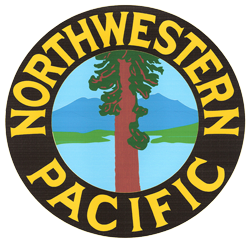From The Headlight March – April 2015
Central Pacific 29
Interior Repairs Are Planned for 2015
By Mike Manson
The 2015 Work Season began on January 24. Jeff Millerick and Richard Fries installed the 8 Z-shaped steel reinforcing plates described in the previous issue of The Headlight. The next session was cancelled on account of rain.
Work on the two new trucks has reached a point where no more can be done until the new pedestals are cast and received at the De Carli Trolley Museum yard in Petaluma. So, this year our focus will be on the interior of the car: stripping paint and removing damaged boards. Our ultimate goal is to bring CP 29 back to its appearance when it came to the NWP.
CP 29 was purchased by the NWP in June 1912 along with five other coaches. According to company records the first four cars in the group, including CP 29 (renumbered to NWP 123), were immediately sent by ship to the railroad’s Northern Division. Until recently we were not certain how the car looked in 1912.
When CP 29 was overhauled by the Central Pacific it received bull-nose roof ends to replace the original duck-bill roof ends. The new design improved the ventilation inside the car. It also eliminated the need for windows in the end walls on either side of the door. Eliminating the end windows eliminated the potential for a passenger to fall against glass while on the car platform.
The original board and batten siding was replaced with tongue-and-groove boards by the CP shop crew. As shown in a drawing obtained from the California State Railroad Museum CP 29 was supposed to have received new interior paneling between the windows. The wood specified in the drawing was walnut, much higher in quality than the T&G boards it currently sports. And the end wall windows were to be covered over with walnut boards too, instead of the T&G boards.
A new book on the NWP’s Northern Division was released in 2013. The book, Images of Rail: Northwestern Pacific Railroad – Eureka to Willits, by O’Hare, Service, and the Fortuna Depot Museum, includes a photograph on page 32 of a steam ship at Fields Landing. Two locomotives, their tenders, and four wooden passenger coaches are clearly visible on the ship’s deck.
Although the cars are at a distance one end of each car is clearly visible. Each car has a bull-nose roof end like CP 29. The door windows are visible, but there are no windows visible in the end walls of the cars. If there was a need to protect end wall windows during the sea voyage, the door windows would have been protected too.
Now that we know CP 29 did not have end windows, we can proceed with stripping the paint on the interior walls and repair or replace damaged boards.
We still need donations for the pedestals. Please remember to make a donation to our “Buy a Pound of Pedestal” campaign. Each donation of $10 will cover the prorated cost of the patterns, steel, sales tax, energy and labor needed to cast one pound of a pedestal for CP 29 and bring it to the De Carli Trolley Museum. Please send a donation today.
1- California State Railroad Museum, Southern Pacific Collection, 1890’s, Series 1, MOLDINGS 77.






